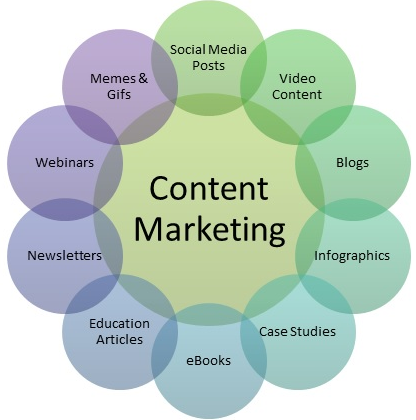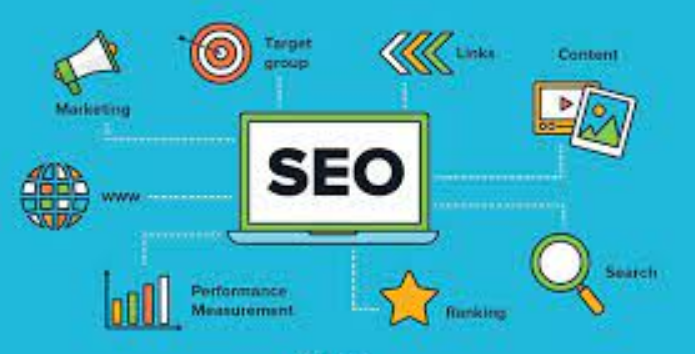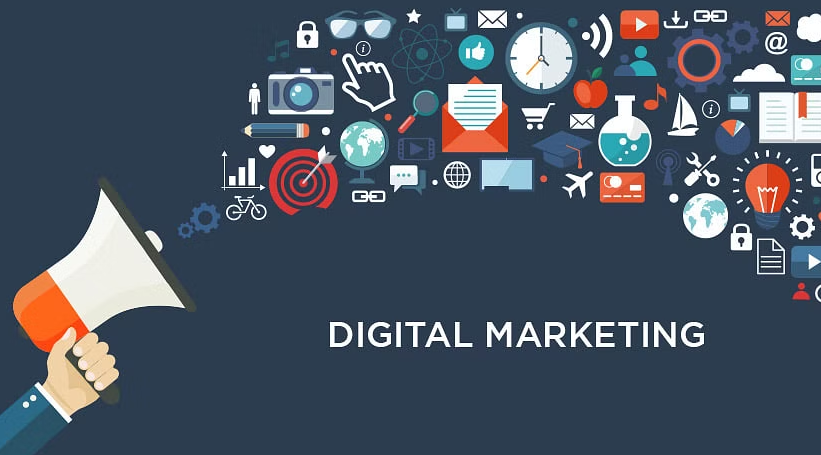Almost all digital marketing campaigns fall into one of six categories: content marketing, search engine optimization, search engine marketing, social media marketing, affiliate and influencer marketing, and email and messaging marketing.
If you want to understand once and for all what digital marketing is, read on. I’ll explain in detail what each type means. You’ll also get some strategies and examples of how to make each one work.
Digital Marketing Types
- Search Engine Marketing (SEM)
- Search Engine Optimisation (SEO)
- Content Marketing
- Affiliate and Influencer Marketing
- Email and Message Marketing
- Social Media Marketing (SMM)
Search Engine Marketing (SEM)

Search engine marketing (SEM) is keyword-based advertising. Advertisers pay for ad space that appears in search results or websites.
On the search results page (pictured above), you have to pay to have your ad appear above, below or next to the organic (unpaid) search results. Google currently identifies ads with a small “ad” icon next to the advertiser’s landing page URL.
When you place ads on a site, you pay to use the site owner’s ad space. They provide space for advertisers by installing Google Adsense or similar software on the site. Each page is associated with specific keywords depending on the page title, content, etc. Things.
To display a particular search term, you need to bid how much you are willing to pay for each click on that term.
Google Ads assigns a quality score to each ad for a particular search query. The higher your ad’s score, the lower the maximum bid you can set and still show your ad. To get a higher score, your ad must.
Have relevant text
Have a high click-through rate
Redirect people to landing pages related to quality.
The more research and practice you put into SEM, the cheaper it becomes. An experienced marketer can use techniques such as ad development and keyword selection to buy traffic at a relatively low cost.
For SEM to pay off, you also need marketable products and landing pages that effectively convert visits into sales.
The cost of advertising varies by industry. For some keywords, there is little competition. The most expensive keywords that are reported to cost more than $50 per click include “marketing services,” “marketplace” and “doctor”
Search Engine Optimisation (SEO)

Search engine optimization (SEO) is about improving the ranking of your web resources in Google, Bing, etc. SEO encompasses a variety of optimization activities that can be used to improve your rankings.
Search engine optimization efforts tend to focus on keywords and phrases relevant to your business. Perhaps the most basic SEO action is incorporating keywords into the title and content of web pages. You want search algorithms to rank your page as a good choice to show people using relevant search terms.
Proper SEO can greatly benefit any online business. A website with high authority can attract a steady stream of potential customers day and night, year after year. On the other hand, a lack of SEO can mean that it’s nearly impossible to find a site through a regular search, the most common way to find content online.
SEO activity can be roughly divided into internal and external. On-page SEO covers what you do with your website (or YouTube videos, etc.) to increase your chances of ranking high. Off-page SEO refers to actions outside of your website, and one of the keys is getting links (backlinks) pointing to it.
For years, the SEO industry has been a battleground. SEO professionals have exploited the weaknesses of search engine algorithms to rank content in clever and often ethically questionable ways. Search engine companies have responded by adjusting their algorithms to prevent system gambling and punish actions that fall outside of their proper code of conduct.
Although gambling and moral dilemmas still exist, search engines are getting smarter. Increasingly, the best way to get high rankings is to do what Google has always asked us to do: provide high-quality content.
Content Marketing

Content marketing is necessary for virtually all forms of digital marketing. Anything that goes beyond classic direct advertising can be considered a form of it.
The idea is to encourage customers to discover your brand, product or service by providing them with useful or interesting content. You don’t just hit them over the head with traditional advertising. Great content attracts an audience of potential customers and leads them to a sale or other profitable action.
Content can be in any digital form and is often based on storytelling. You can promote what you have through blog posts, guest posts, press releases, videos, social media posts, digital books, online courses and even comparison tools and calculators.
Your content should be informative and/or engaging so that people actively seek it out. Ideally, your role to potential customers is more than just an advertiser. Instead, you may be accepted as an associate, partner, artist or teacher.
Content marketing can be very effective because your target audience benefits from it. In this way, you can attract more people by gaining trust and confidence. Then the right strategy can turn successful audience capture into sales.
Most types of digital marketing rely on content, including social media marketing, search engine optimization and email marketing. Without good content, these campaigns would be difficult and/or ineffective.
Affiliate and Influencer Marketing

Affiliate marketing is when you pay your affiliates (affiliate marketing companies) for referrals or traffic that generate sales. It’s similar to hiring a digital salesperson to sell your product or service. Affiliates may place links or advertisements on their Web sites that lead to product pages on your Web site.
Affiliates usually receive a percentage of sales (e.g., 12%) as a commission. You can set a non-negotiable payment rate or, especially if you are dealing with several influential partners, you can negotiate a rate. A higher percentage encourages partners to work harder to increase sales.
Software and platforms are available where the necessary technical work is done for you. The online marketplace provided by CJ Affiliate brings vendors and suppliers together. Affiliates are often the owners of high-traffic websites and blogs.
Another way to increase your brand awareness is to use a special type of affiliate: influencers. This is a celebrity who has many subscribers online or on social media.
You can expand your audience by paying influencers or engaging them to support your brand, product or service. Influencer-led promotions not only generate online traffic, but also bring other benefits such as prestige and brand credibility.
With affiliate marketing, you can set certain rules to maintain brand integrity. At the same time, it’s better to give affiliates enough freedom to use proven styles to connect with their audiences. Affiliate marketing works best when the promotion looks like a real endorsement, not just a paid advertising service.
Email and Message Marketing

Email and messaging marketing is when you sell directly to potential or existing customers via email or other messaging channels such as text messages or via Messenger. Email and messaging marketing is known as spamming or spamming unless you have the recipient’s permission to contact them in this way.
Ideally, every recipient in a marketing campaign could give their address and would not be surprised to receive an email from the sender. Every email or message should always provide an opportunity to unsubscribe or otherwise opt out of receiving emails from the sender.
Labeling outgoing emails as spam by multiple recipients can cause problems for your business. Email blockers can prevent some or all emails from your address from reaching intended recipients. Authentication standards such as DKIM and SPF help your company send email without being blocked by filters.
For obvious reasons these days, people are reluctant to share their contact information because of spam. But one way to solve this problem is to offer something of value in return. For example, it could be a free e-book, a downloadable guide, or other information.
Email and messaging marketing can make a huge difference when applied to known customers. These can be people who have previously purchased your product or service, or people who have signed up to purchase but haven’t actually completed the transaction. An email about a product or service they’re interested in, especially from a company they’re familiar with, can easily remind or encourage them to make a repeat or first purchase.
You can also use email content marketing to promote your brand, product or service. Subscribers to newsletters, blogs or other information services are at least somewhat receptive to useful content. You can promote products and services in emails, including commercial offers, while providing value to your subscriber base.
Social Media Marketing (SMM)

Another major type of digital marketing is social media marketing (SMM). It is about using social media platforms to attract attention and traffic. Popular platforms include Facebook, YouTube, Instagram, Twitter, Pinterest, LinkedIn and SnapChat.
You can use social media to enhance the image of your business. Social media platforms allow you to directly promote your brand, products and services. Through its “pixels,” Facebook allows you to digitally track people who visit your site and then display your ads in their Facebook feed.
Similarly, social media marketing is a way to attract potential customers and build relationships with them. You can post content that is relevant to your target audience and keep them engaged and engaged.
Posted content can be used to educate, entertain or capture the attention of your audience. To do well, digital marketers need a good understanding of the platform, including content sharing models and the tastes of their target audience.
Getting subscribers is an effective way to build a ready-made audience. However, these platforms customize their algorithms to limit the extent to which unpaid posts reach their audience, even subscribers. This forces companies to turn to paid advertising to get results.
The companies that do best with social media marketing include business-to-consumer companies and software-as-a-service companies. To see if the platform is right for your business, you need to start by using it and see what types of ads appear most often.






